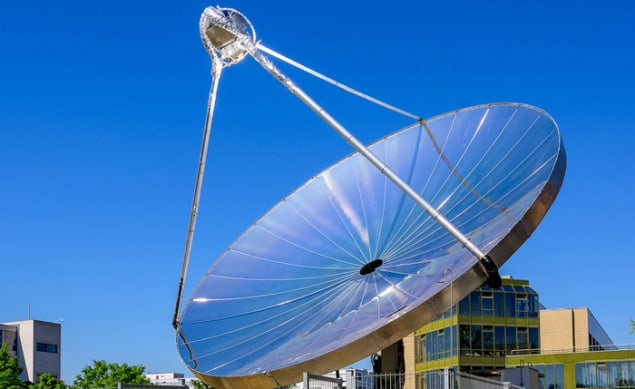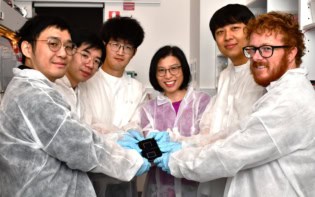
A new solar-radiation-concentrating device produces “green” hydrogen at a rate of more than 2 kilowatts while maintaining efficiencies above 20%. The pilot-scale device, which is already operational under real sunlight conditions, also produces usable heat and oxygen, and its developers at the École polytechnique fédérale de Lausanne (EPFL) in Switzerland say it could be commercialized in the near future.
The new system sits on a concrete foundation on the EPFL campus and consists of a parabolic dish seven metres in diameter. This dish collects sunlight over a total area of 38.5 m2, concentrates it by a factor of about 1000 and directs it onto a reactor that comprises both photovoltaic and electrolysis components. Energy from the concentrated sunlight generates electron-hole pairs in the photovoltaic material, which the system then separates and transports to the integrated electrolysis system. Here, the energy is used to “split” water that is pumped through the system at an optimal rate, producing both oxygen and hydrogen.
Putting it together at scale
Each of these processes has, of course, been demonstrated before. Indeed, the new EPFL system, which is described in Nature Energy, builds on previous research from 2019, when the EPFL team demonstrated the same concept at laboratory scale using a high-flux solar simulator. However, the new reactor’s solar-to-hydrogen efficiency and hydrogen production rate of around 0.5 kg per day are unprecedented in large-scale devices. The reactor also produces usable heat at a temperature of 70°C.
The versatility of the new system forms a big part of its commercial appeal, says Sophia Haussener, who leads the EPFL’s Laboratory of Renewable Energy Science and Engineering (LRESE). “This co-generation system could be used in industrial applications such as metal processing and fertilizer manufacturing,” Haussener tells Physics World. “It could also be used to produce oxygen for use in hospitals and hydrogen for fuels cells in electric vehicles, as well as heat in residential setting for heating water. The hydrogen produced could also be converted to electricity after being stored between days or even inter-seasonally.”

Why you should concentrate on this form of solar power
Haussener and colleagues are now busy scaling up their system further in an environment where individual reactors are deployed in a modular fashion, like trees in an artificial garden. A LRESE spin-off, SoHHytec SA, is deploying and commercializing the technology, and is working with a Switzerland-based metal production facility to build a demonstration plant on the multi-100-kilowatt scale.
Another future direction for the team could be to develop a similar system to convert CO2 into CO, ethylene or other products plus oxygen. “This would allow us to valorize CO2 and produce other precursors for industrial processes,” Haussener explains. “For example, ethylene could be used in green plastic production, and CO together with hydrogen for liquid fuel production.”



